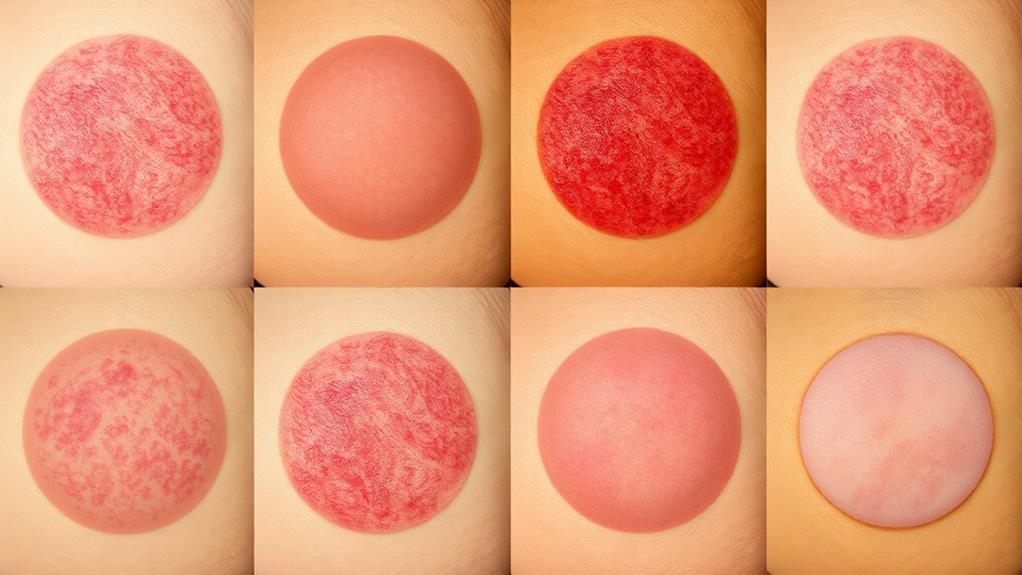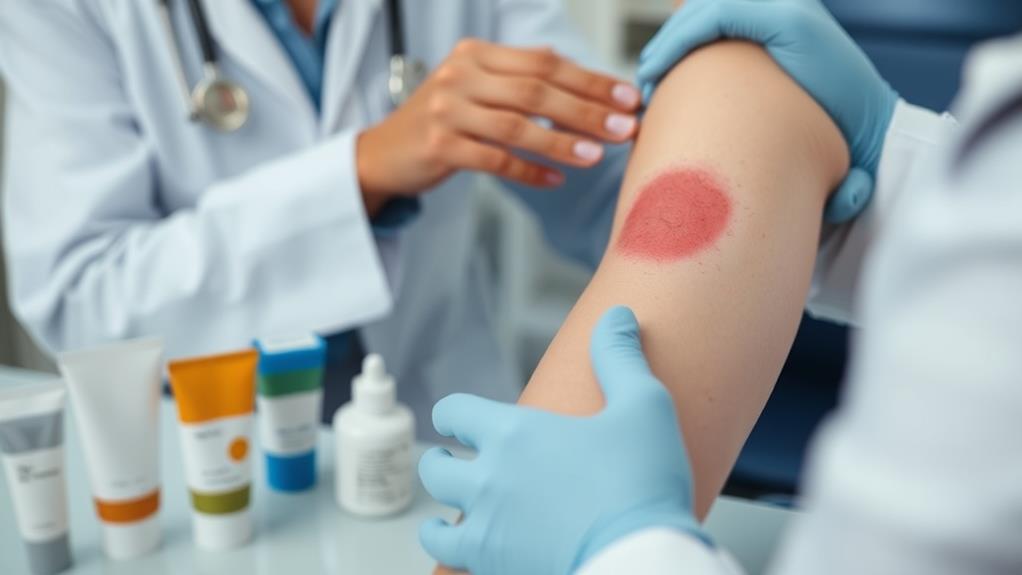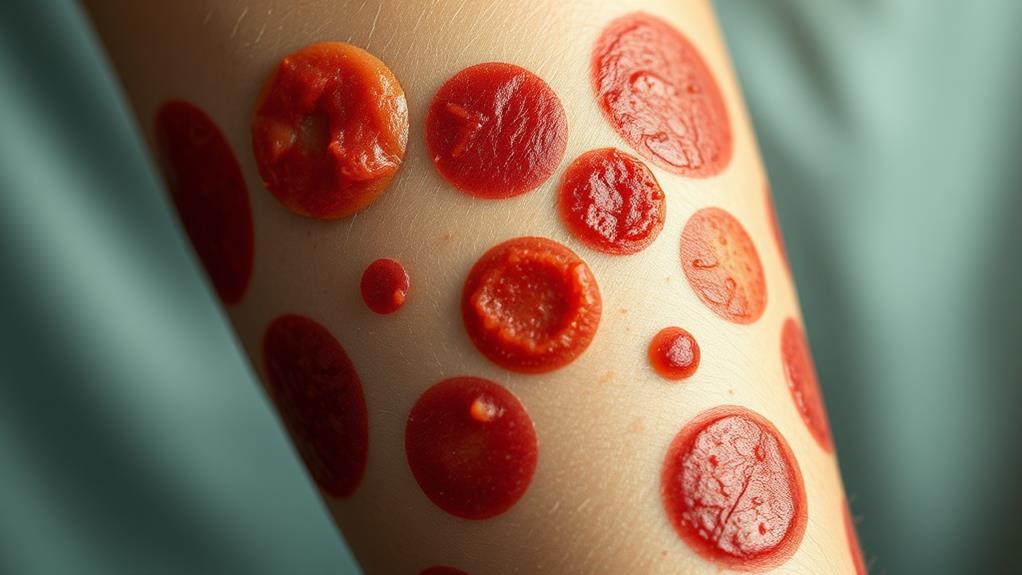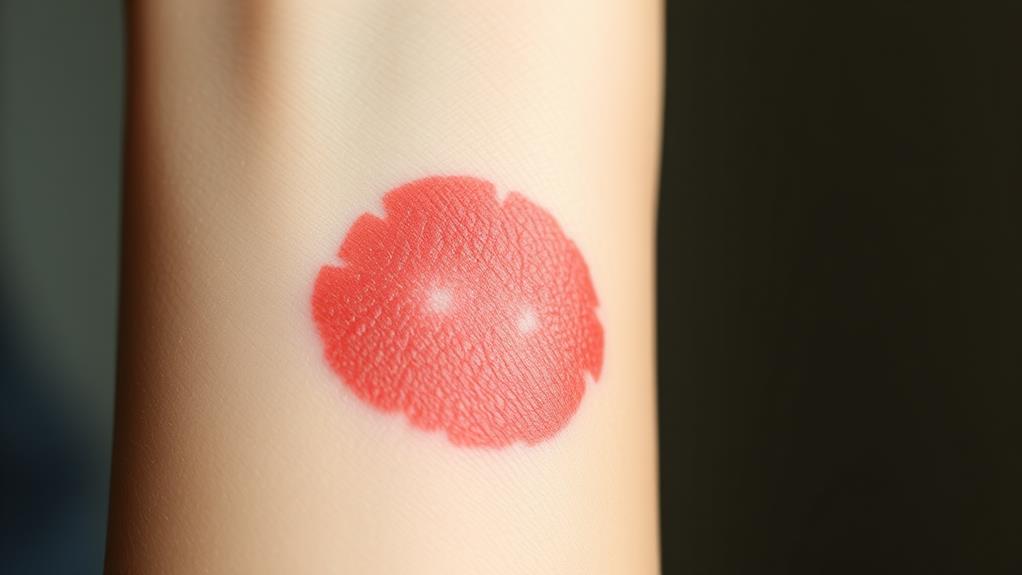When you notice a red, circular rash on your skin, it's easy to jump to conclusions and assume it's ringworm. However, not all circular rashes are created equal, and distinguishing between them can be more complicated than you might think. You may find that conditions like eczema or even Lyme disease can mimic these symptoms. Understanding the nuances is essential, especially when considering treatment options. But what are the key differences you should look out for, and why does it matter? Let's explore this topic further.
Common Causes of Circular Rashes

Circular rashes can arise from a variety of skin conditions, and knowing the common causes can help you identify what you're dealing with.
One well-known cause is ringworm, a fungal infection that creates a circular rash with scaly patches. However, other conditions can mimic this appearance. For instance, eczema includes different forms like nummular eczema, which produces coin-shaped itchy patches due to dry skin, stress, or allergies.
Lyme disease also features a circular rash, often resembling a "bull's-eye," and it's usually associated with tick bites.
Then there's granuloma annulare, a chronic condition that manifests as raised ring-shaped bumps, often seen in children, with its causes still unclear.
Finally, pityriasis rosea typically presents with circular or oval rashes and often resolves on its own, possibly linked to viral infections like the cold sore virus.
Understanding these common causes can be a big help in figuring out what's causing your circular rash.
If you're ever unsure, it's a good idea to consult a healthcare professional to get the right diagnosis and treatment.
Distinguishing Ringworm From Other Conditions
Identifying whether you have ringworm or another skin condition can be challenging, especially since some rashes share similar appearances.
Ringworm typically shows up as a circular rash that's raised and scaly, often with a clear center. In contrast, conditions like nummular eczema may present coin-shaped, itchy patches that can ooze or crust over. You won't usually see that with ringworm.
Lyme disease can confuse things too; it causes a distinctive "bull's-eye" rash that appears weeks after a tick bite. If you notice this, it's likely not ringworm.
Granuloma annulare features raised bumps that form rings but is non-contagious, unlike the fungal infection of ringworm.
Don't forget about contact dermatitis, which can mimic ringworm with its circular lesions but usually stems from an allergic reaction.
Pityriasis rosea can create similar circular rashes as well, but it comes from a viral infection rather than a fungal cause.
To sum it up, paying attention to the specific symptoms and characteristics of your rash can help you distinguish ringworm from these other skin conditions.
If you're unsure, consulting a healthcare professional is always a good idea!
Symptoms of Ringworm and Similar Rashes

Presenting as a distinct rash, ringworm often features a raised, scaly border with a clearer center, typically causing itchiness that can be uncomfortable. This circular rash can appear in various colors, like red, brown, or even skin-toned, and may grow larger over time.
You might confuse ringworm with other conditions. For instance, eczema can create coin-shaped patches that are dry and just as itchy. On the other hand, psoriasis shows up as thick, silvery scales on red patches of skin.
Another similar condition is granuloma annulare, which has raised, firm bumps that form a ring, but it's non-contagious and can hang around for years.
Keep an eye out for Lyme disease, too! It can show up as a bullseye rash, appearing days or weeks after a tick bite. This rash has a central clear area surrounded by a red ring and might come with flu-like symptoms.
Understanding these differences can help you identify what you're dealing with. If you notice a circular rash that's itchy and raised, it could be ringworm or a similar rash, so it's best to consult a healthcare professional for further guidance.
Diagnosis and Evaluation Process
When you're dealing with a suspicious rash, the diagnosis process starts with a thorough visual assessment by a healthcare provider. They'll closely examine the appearance of the circular rashes, their location, and any accompanying symptoms. This evaluation is vital for understanding what might be causing your rash.
Your patient history is also a key part of the diagnosis. Sharing details about potential triggers, recent exposures, and how long you've had the symptoms helps the healthcare provider make informed decisions.
In some cases, they may perform a KOH test to confirm or rule out fungal infections like ringworm. This test involves taking a sample from the rash and examining it under a microscope.
If the situation is still unclear, a skin biopsy might be necessary. This procedure allows for a deeper look at the skin cells and can identify underlying conditions that might be causing your rash.
Remember, timely evaluation and professional intervention are essential for persistent or worsening circular rashes. This guarantees you get appropriate treatment and prevents complications down the line.
Treatment Options for Circular Rashes

Once a healthcare provider has evaluated your circular rash and determined the underlying cause, it's time to explore treatment options.
If your rash is due to a ringworm infection, antifungal creams are typically the go-to treatment. These creams can help eliminate the fungus and alleviate discomfort.
In cases of inflammatory conditions like eczema or psoriasis, topical corticosteroids can be effective. They reduce inflammation and ease symptoms associated with these rashes.
If your rash is itchy due to an allergic reaction or contact dermatitis, over-the-counter antihistamines can provide relief.
For severe cases of psoriasis or granuloma annulare, your provider might prescribe systemic medications to guarantee a thorough approach to treatment.
Importance of Professional Consultation
Understanding the importance of professional consultation is essential for addressing circular rashes effectively. When you notice a rash, consulting a dermatologist can be critical for accurately diagnosing circular rashes. Many skin conditions can look like ringworm, which might lead to misdiagnosis and ineffective treatment.
A professional evaluation allows the use of diagnostic tests, like the KOH test or skin biopsy, to confirm if a fungal infection is present or if another skin disorder is at play.
By seeking early intervention, you can prevent complications associated with untreated skin conditions, which could worsen your symptoms or even lead to secondary infections. Dermatologists can create tailored treatment plans that cater to your individual symptoms and needs, ensuring you get the best care possible.
Additionally, regular follow-up appointments are essential for monitoring progress, especially if you're dealing with chronic or persistent rashes. These check-ins allow your dermatologist to adjust your treatment as needed, keeping your skin healthy and reducing the risk of complications.
Misconceptions About Ringworm

Many misconceptions surround ringworm, leading to confusion about this common skin condition. First off, it's important to clarify that ringworm isn't caused by actual worms; it's a fungal infection that infects the outer layer of your skin.
You might think that only those with poor hygiene get ringworm, but that's not true! This contagious skin rash can affect anyone, regardless of cleanliness.
Another common myth is that ringworm only appears on the body. In reality, it can also infect your scalp, leading to tinea capitis, and even your feet, causing athlete's foot.
You may also believe it's only a problem in warm climates, but ringworm can pop up anywhere, especially in crowded places.
Many people assume that over-the-counter treatments are enough to cure this condition, but severe cases might need prescription antifungal medications for proper treatment.
Don't let these misconceptions mislead you! If you notice red circular rashes or persistent skin issues, it's best to consult a healthcare professional for accurate diagnosis and effective treatment options.
Reliable Sources for Skin Health Information
Accessing reliable sources for skin health information is vital for making informed decisions about your skin care.
When you're looking for guidance on skin conditions, the Centers for Disease Control and the American Academy of Dermatology are two excellent places to start. These organizations provide accurate information and treatment guidelines based on peer-reviewed studies and expert opinions, helping you understand various skin issues.
Websites like Medical News Today and Verywell Health also compile information from reputable healthcare institutions. They guarantee that you're reading content backed by scientific research, which is significant when dealing with skin health.
You can find details on preventive measures and the latest treatment options, keeping you up-to-date.
